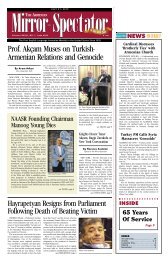Inspirational Vergin Mazmanian, 103, Dies Bipartisan Genocide ...
Inspirational Vergin Mazmanian, 103, Dies Bipartisan Genocide ...
Inspirational Vergin Mazmanian, 103, Dies Bipartisan Genocide ...
You also want an ePaper? Increase the reach of your titles
YUMPU automatically turns print PDFs into web optimized ePapers that Google loves.
My Turn<br />
By Harut Sassounian<br />
From <strong>Genocide</strong> Recognition To<br />
Reclaiming Church Properties<br />
The Armenian-American community took a major step<br />
last week to reverse the consequences of the Armenian<br />
<strong>Genocide</strong> and end the Turkish government’s long-standing<br />
policy of erasing all traces of Armenian civilization from<br />
present-day Turkey.<br />
Going beyond mere acknowledgment of the Armenian<br />
<strong>Genocide</strong>, some members of Congress have introduced a<br />
new resolution that urges “the Republic of Turkey to safeguard<br />
its Christian heritage and to return confiscated<br />
church properties.”<br />
The sweeping House Resolution 306 calls on the government<br />
of Turkey to:<br />
1) end all forms of religious discrimination;<br />
2) allow the rightful church and lay owners of Christian<br />
church properties, without hindrance or restriction, to<br />
organize and administer prayer services, religious education,<br />
clerical training, appointments and succession, religious<br />
community gatherings, social services, including ministry<br />
to the needs of the poor and infirm and other religious<br />
activities;<br />
3) return to their rightful owners all Christian churches<br />
and other places of worship, monasteries, schools, hospitals,<br />
monuments, relics, holy sites and other religious properties,<br />
including movable properties, such as artwork, man-<br />
By Harry Koundakjian<br />
While some criminals guilty of committing genocide (such as those in Serbia or Germany) are<br />
brought to trial, the majority go free, never penalized for their horrific crimes. In particular, the<br />
Armenians live with the unacknowledged <strong>Genocide</strong> of 1.5 million Armenians, and the perpetrators<br />
have never been charged. Among the victims was my great-grandfather, the<br />
Reverend Hagop Koundakjian, who was burned alive near his town church<br />
Opinion with 28 of his parishioners. My great-grandmother, Yeretzgin Maryam, reported<br />
this in a letter in which she explains how she had to walk behind the<br />
Turkish officers’ horses to collect their manure and try to cook the undigested seeds for her children<br />
and grandchildren.<br />
Great-grandmother Yeretzgin Maryam (Mary) Koundakjian writes: “I wish I had not been compelled<br />
to write about the terrible and frightening tragedies that took place.<br />
“The catastrophe struck like lightning. With tears in my eyes, I write to you. Your father (Rev.)<br />
Hagop Koundakjian was luckier than we were, because at the beginning of the catastrophe, on<br />
the road to Adana, he was killed and did not see the sudden destruction and premeditated attacks<br />
on our city. He did not witness the burning of his city, did not hear the shocking and frightening<br />
shooting by the cruel and heartless enemy.<br />
“He did not see his sisters, brothers and relatives shot to death indiscriminately.<br />
“On April 11, 1909, we had our communion (at church, during the worship service). It was a<br />
rather heartfelt ceremony. Nobody knew or imagined that this would be his last sermon.<br />
“On the next day father journeyed for the annual Armenian Evangelical Church conference.<br />
“As you might have heard already, all in the group of 28 from Osmaniah were burned alive with<br />
your father. I want to assure you, my children, that all these difficulties, threats of persecutions and<br />
doomsday announcements have strengthened us in our faith — Christianity — and belief in God.<br />
“On April 16th, a gang of wild Turks, Kurds and Circassians attacked Hassanbeyli. Our youth,<br />
with their limited arms, protected us heroically but the enemy fighters advanced like locusts,<br />
obliging us to take cover in the nearby hills. We prayed to the Lord to protect us.<br />
“We were driven and took refuge at Bahche, where we still are today. They (the Ottoman Turks)<br />
threatened us with death if we did not convert to and accept Islam. We are very tired. We are<br />
near half-dead.<br />
“Everything was destroyed. The church, in which your father served for over 30 years, disappeared.”<br />
This is a fraction of the letter written by our great-grandmother found so far. All our efforts to<br />
locate the rest have been in vain. But we continue the search.<br />
Having been born into an Evangelical family, I only have this portion of our people’s story, but<br />
I understand from very reliable sources that Bishop Papken Charian of the Apostolic<br />
Brotherhood wrote his dissertation on this same issue. He had collected all the martyrs from the<br />
three denominations (Apostolic, Catholic and Evangelical) and published it in a single volume.<br />
This is also translated into English. You all can get this book under the title Nahadag Hay<br />
Hokevoraganner (Martyred Armenian Clergy).<br />
Last December, during a two-day forum attended by <strong>Genocide</strong> scholars from about 20 countries,<br />
Armenia’s President Serge Sargisian said broader international recognition of the Armenian<br />
<strong>Genocide</strong> is essential for preventing more crimes against humanity:<br />
“The bitter lessons of the Armenian <strong>Genocide</strong> did not go down in the history and memory of<br />
humankind as mere memories of the past. They came to be replaced by the horrors of the<br />
Holocaust and the tragedies in Rwanda, Darfur and many other places.”<br />
S A T U R D A Y, J U N E 2 5 , 2 0 1 1 T H E A R M E N I A N M I R R O R - S P E C TAT O R 19<br />
COMMENTARY<br />
uscripts, vestments, vessels and other artifacts; and<br />
4) allow the rightful Christian church and lay owners of<br />
Christian church properties, without hindrance or restriction,<br />
to preserve, reconstruct and repair, as they see fit, all<br />
Christian churches and other places of worship, monasteries,<br />
schools, hospitals, monuments, relics, holy sites and<br />
other religious properties within Turkey.”<br />
This bipartisan resolution, sponsored by Rep. Ed Royce (R-<br />
CA) and Rep. Howard Berman (D-CA), was immediately<br />
endorsed by 30 of their House colleagues, 10 of them<br />
Republicans. This is a good start, as Republicans constitute<br />
the majority in the House and their support is crucial for the<br />
successful passage of the resolution. Significantly, Rep. Ileana<br />
Ros-Lehtinen (R-FL), chair of the House Foreign Affairs<br />
Committee and a long-time opponent of the Armenian<br />
<strong>Genocide</strong> resolution, was one of the first supporters of the resolution<br />
regarding the return of church properties.<br />
It is not surprising that this resolution has such broad<br />
support, as it is hard to imagine that any member of<br />
Congress, the State Department or the Obama administration<br />
would oppose returning a religious building back to its<br />
proper owners. By contemporary societal standards, no<br />
one would accept the conversion of a church into a mosque<br />
or vice versa. Turkey’s devout leaders, as good Muslims,<br />
would be the first to acknowledge and uphold the sanctity<br />
of houses of worship.<br />
Beyond building a strong bipartisan coalition in<br />
Congress, practically all religious denominations in<br />
America, be they Evangelical, Catholic, Orthodox, Jewish<br />
or Muslim, would support such a resolution. All ethnic<br />
groups, such as Latinos, Greek-Americans, Irish-Americans,<br />
Jewish-American, Arab-Americans, Afro-Americans, Asian-<br />
Americans and Assyrian-Americans would also lend their<br />
support to this resolution.<br />
The Armenian National Committee of America noted<br />
that the resolution intends “to highlight, confront and<br />
eventually reverse decades of official Turkish policy of<br />
destroying Christian church properties, desecrating holy<br />
sites, discriminating against Christian communities and<br />
denying of the right of Armenians, Greeks, Assyrians,<br />
Chaldeans, Pontians, Arameans (Syriacs) and others to<br />
practice their faith in freedom.”<br />
The right to religious freedom is not simply an internal<br />
Turkish issue. This right is protected by many international<br />
agreements, including the United Nations’ Universal<br />
Declaration of Human Rights, the European Convention<br />
on Human Rights and the 1923 Treaty of Lausanne to<br />
which Turkey is a signatory. Turkey continues to violate<br />
Articles 41 and 42 of the Lausanne Treaty which obligate<br />
it to provide funding and facilities to non-Muslim minorities<br />
for educational, religious and charitable purposes and to<br />
protect their religious establishments. Regrettably, the<br />
House resolution makes no mention of these violations and<br />
Turkey’s obligations under the Lausanne Treaty.<br />
The US Commission on International Religious<br />
Freedom, which issues an annual report documenting violations<br />
of religious rights around the world, has placed<br />
Turkey on its “Watch List,” for the third year in a row. The<br />
Commission has found that “the Turkish government continues<br />
to impose serious limitations on freedom of religion<br />
or belief, thereby threatening the continued vitality and<br />
survival of minority religious communities in Turkey.” The<br />
Turkish government also “continues to intervene in the<br />
internal governance and education of religious communities<br />
and to confiscate places of worship.”<br />
In recent years, the House and Senate passed several resolutions<br />
calling on Turkish-occupied Northern Cyprus,<br />
Lithuania, Romania and Vietnam to protect houses of worship<br />
and return wrongfully confiscated properties belonging<br />
to religious minorities. In line with these resolutions,<br />
the House of Representatives should adopt Resolution 306,<br />
calling on the Turkish government to respect the right of<br />
worship for all Christian minorities and return to them<br />
their expropriated churches and other religious properties.<br />
Time for Justice for <strong>Genocide</strong> Victims<br />
Foreign Minister Eduard Nalbandian of Armenia made the same point: “<strong>Genocide</strong> denial and<br />
impunity pave the way for new crimes against humanity. Regardless of geopolitical or other interests,<br />
the international community must be united in condemning and preventing genocide.”<br />
A comment made around the world was, “I want to hear the words, ‘Armenians across the<br />
world, along with the Republic of Armenia, demand reparations for the crime of genocide and<br />
the rightful return of our confiscated lands.”<br />
My anger is because of this: What are our political leaders around the world doing to compel<br />
the great powers — the US, Great Britain, France, Russia and Germany — to make clear to successive<br />
Turkish governments that either they accept these facts as truly <strong>Genocide</strong>, and if not, that<br />
they would break off relations with Turkey. Turkey is acting like a superpower now around the<br />
world in order to get into the European Union. This should not happen. Yes, I know they are 80<br />
million now, but surely we can prove that some of them — or perhaps many, many of them — have<br />
Armenian blood in their veins. Many of their earlier leaders were not Turks anyway; they were<br />
known as ‘Deunmeh’ or converts.<br />
Not many people know about our Tricolor flag. It is known as Yerakoouyn and consists of<br />
three horizontal bands of red, blue and orange. The meaning of the colors have been interpreted<br />
in different ways. Red stood for the blood shed by Armenian soldiers in war, blue for the<br />
Armenian sky and the orange represents for fertile lands of Armenia and workers who work<br />
there. The official definition of the colors, as stated in the Constitution of the Republic of<br />
Armenia, is: The red emblematizes people’s continued struggle for survival, and for the blood our<br />
brave ancestors shed, fighting the enemy and sacrificing their lives to save the Armenian nation<br />
from annihilation, ensure their freedom to practice their Christian faith, Armenia’s independence<br />
and freedom. The blue is for the people of Armenia to live beneath peaceful skies and the orange<br />
symbolizes the creative talent and hard-working nature of the people of Armenia. Long live the<br />
flag of Armenia. History of the Armenian flag says it was created after the First World War<br />
between 1918 and 1921, after Armenian gained independence and was readopted on Aug. 24<br />
1990, just before gaining independence from the Soviet Union in 1991.<br />
It is a must for all Armenian families to read about and remember our Martyrs. They should<br />
not and cannot be forgotten.<br />
(Harry Koundakjian was chief photographer for the Associated Press<br />
in the Middle East and North Africa for many years.)<br />
Notice to Contributors<br />
The Armenian Mirror-Spectator welcomes articles,<br />
commentaries and community news from our readers. In<br />
order to assure the accurate and timely publication of<br />
articles submitted, please note the following policies:<br />
— All articles submitted should be typed, double (or<br />
triple) spaced and printed in a type size large enough to<br />
be clearly legible (10 point or larger). Submissions that<br />
do not conform to these specifications will be assigned<br />
lowest priority.<br />
— Articles sent by fax are acceptable, and e-mail submissions<br />
are encouraged.<br />
— All submissions should include the name of a con-<br />
tact person and a daytime telephone number.<br />
— Deadline for submission of all articles and advertising<br />
is 12 noon on Monday of the week of publication.<br />
— Photos will be published without charge at the discretion<br />
of the editors and art director. Photos will be returned<br />
only if a self-addressed and stamped envelope is included.<br />
— The M-S will publish only one article about an upcoming<br />
organizational event. For major special events,<br />
exceptions may be made only by special arrangement<br />
with the editors.<br />
— Telephone numbers, ticket prices and other details (at<br />
the discretion of the editors) will not be included in press<br />
releases, but should be reserved for calendar listings and<br />
advertisements.














